Content
Published:
This is an archived release.
Households discard more than ever
In 2013, the municipalities handled 2.3 million tonnes of household waste, which is about 84 000 tonnes more than in 2012. Around 880 000 tonnes of waste were either sent to material recovery, fermentation or composting.
| Total | Per cent | ||||
|---|---|---|---|---|---|
| 1992 | 2012 | 2013 | 1992 - 2013 | 2012 - 2013 | |
| 1The figures have been adjusted to correct for interference of industrial waste in household waste | |||||
| 2Sent to material recovery includes composting and fermentation | |||||
| Total. 1000 tonnes. | 1 012 | 2 173 | 2 255 | 123 | 4 |
| Kg per inhabitant | 237 | 430 | 441 | 86 | 3 |
| Sent to material recovery. 1000 tonnes.2 | 86 | 866 | 884 | 929 | 2 |
| Sent to material recovery. Kg per inhabitant.2 | 20 | .. | 173 | .. | .. |
| Income from fees per inhabitant (NOK) | 917 | 947 | 3 | ||


On average, each inhabitant generated 442 kg of household waste in 2013. This is 12 kg more than in 2012. The figures show a connection between consumption and waste generation. Consumption increased by 2.1 per cent in 2013, while waste generation increased by 3.3 per cent. For every NOK 1 000 spent on consumption, Norwegians generate 2 kg of household waste.
Recovery rate is going up
The waste sent to energy and material recovery constituted 1.9 million tonnes, or 83 per cent of all household waste in 2013, which is the same share as for 2012. The amount of waste sent to energy recovery includes 160 000 tonnes of mixed waste exported for energy recovery.
From the total amount of household waste in 2013, waste sent to material recovery amounts to 39 per cent. This share has remained steady over the last couple of years.
Incineration gaining ground
The treatment of increasing amounts of waste from households is managed by incineration plants. Incineration has also reduced the amounts put on landfills. In 2013, around 1.3 million tonnes of household waste were incinerated, which is twice as much as in 2004. Of the 1.3 million tonnes of waste that was incinerated, 340 000 tonnes was sorted waste, and mainly wood waste. Approximately 950 000 tonnes was mixed waste.
Edible food thrown away
Around 174 000 tonnes of food waste and other materials were sorted for composting and fermentation in 2013. In 120 municipalities, the food waste is incinerated together with mixed waste. On average in 2011, each inhabitant discarded 78 kg of food waste, of which 46 kg was edible. The remainder was peel, coffee grounds and other inedible substances.
Smaller contribution from Svalbard
The inhabitants in Longyearbyen on average got rid of 180 kg of household waste in 2013. This is 36 kg less than in 2011. Mainland inhabitants discard more than twice as much in a year. All households in Longyearbyen have installed food waste disposers. This reduces the waste collected. Other explanations for the low amounts of waste could be that the inhabitants often do not stay for several years and live in quite small apartments.
About average in Europe
Norway generated 477 kg of municipal waste per capita in 2012, which is 15 kg less than the average in Europe. Municipal waste is the sum of waste from households and the household-like waste from industry handled by the municipalities.
Comparisons between countries may be uncertain since the coverage and managing of municipal waste varies within the EU.
Income from fees slightly lower than the fee calculation basisCosts in the municipal waste sector are covered by fees paid by the users of the service. Regulations stipulate that fees shall cover all the costs in the municipal waste service, and cannot exceed the actual costs for providing that service, i.e. self cost principle. Accurately stipulating income from fees to cover the real calculation basis in a single year is complicated, thus the municipalities are allowed to decide on fee levels so that income from fees over a five-year period equal the fee calculation basis.
In 2013, the fee calculation basis per inhabitant increased by 5 per cent compared to 2012. The income per capita from fees increased by 4.3 per cent from 2012.
The income from fees in 2013 was about 3.4 per cent lower than the fee calculation basis for that year. For the whole five-year-period from 2009 to 2013, this has nearly evened out. Total income from fees was 1 per cent lower than the fee calculation basis.
Contact
-
Camilla Skjerpen
E-mail: camilla.skjerpen@ssb.no
tel.: (+47) 48 22 72 14
-
Mona E. Onstad
E-mail: mona.onstad@ssb.no
tel.: (+47) 48 59 61 86
